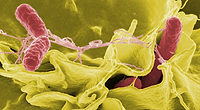Foodborne Salmonella Outbreak Points to Drainage Systems as a Contamination Risk Factor

Image credit: Daniel Dan via Unsplash
A recent analysis of a Canadian foodborne salmonellosis outbreak investigation has highlighted the importance of considering possible aerosolization of bacteria from drainage systems in restaurants as a risk factor for foodborne illness outbreaks.
In May 2020, the Public Health Department of the Integrated University Health and Social Services Center of the Capitol of Quebec (DSPu) received a report from the Quebec Public Health Laboratory about a cluster of Salmonella infections. The epidemiological investigation identified a total of 67 cases between January 1, 2020 and August 13, 2021, 66 percent of which were directly linked to a local restaurant. The Salmonella strains from most of the cases were found to be identical by whole genome sequencing (WGS).
After the investigation found the restaurant to be the likely source of the outbreak, the Quebec Ministry of Agriculture, Fisheries, and Food (MAPAQ) inspected the establishment, but did not note any hygiene or food safety deficiencies, nor did any of the restaurant staff report gastrointestinal symptoms in the preceding weeks. Food samples taken from ready-to-eat (RTE) and raw chicken, which was initially suspected to be the vehicle of the outbreak, were also found to be negative for Salmonella.
During a second visit by MAPAQ to the establishment, food samples taken from coleslaw salad were negative for Salmonella. On the same day, the MAPAQ collected environmental samples from work surfaces, knives, door handles, sinks, and drains. Salmonella bacteria was detected by a polymerase chain reaction (PCR) test at several locations in the restaurant. A month later, MAPAQ received confirmation that the strains detected in the environment matched those of the human cases. In the following weeks, MAPAQ visited the establishment on several occasions to disinfect the site and take additional environmental samples.
The investigators pursued the hypothesis of persistent environmental contamination causing contamination of food served in the restaurant through aerosols. Several sample sites tested positive for Salmonella Montevideo in the establishment throughout the epidemiological investigation, repeatedly but variably. The positive results were mainly from sites such as the underside of a shelf, sink drains, and the floor drain. Several rounds of cleaning and disinfection were carried out by the restaurant’s management team, and samples were taken before and after each disinfection procedure to verify its effectiveness.
Several sample sites that were initially positive turned out to be negative after a cleaning and disinfection operation. Other sites were more difficult to decontaminate, testing positive again in post-intervention control samples. On several occasions, contamination was detected in areas where it had not previously been present.
The restaurant’s main sink was replaced on September 10, 2020, due to its age and to the impossibility to decontaminate it. Unfortunately, new cases of salmonellosis occurred even after this sink was replaced. Then, one particular sampling site—the drain in the dishwashing sink—repeatedly tested positive between January and March 2021.
All environmental samples collected after March 25, 2021, were found to be negative. The last sample was taken on July 8, 2021.
The most plausible explanation for the origin of the outbreak was decided to be contaminated drains in the establishment. Prior to the outbreak, a kitchen fire resulted in firefighters using a powder extinguisher and water jet to contain and extinguish the flames, which the investigators hypothesize could have introduced Salmonella contamination to the kitchen drains. The hypothesis raises questions about the need to recommend a routine drain cleaning operation following a restaurant kitchen fire when fire suppression requires the use of water that comes into contact with food.
Looking for a reprint of this article?
From high-res PDFs to custom plaques, order your copy today!






